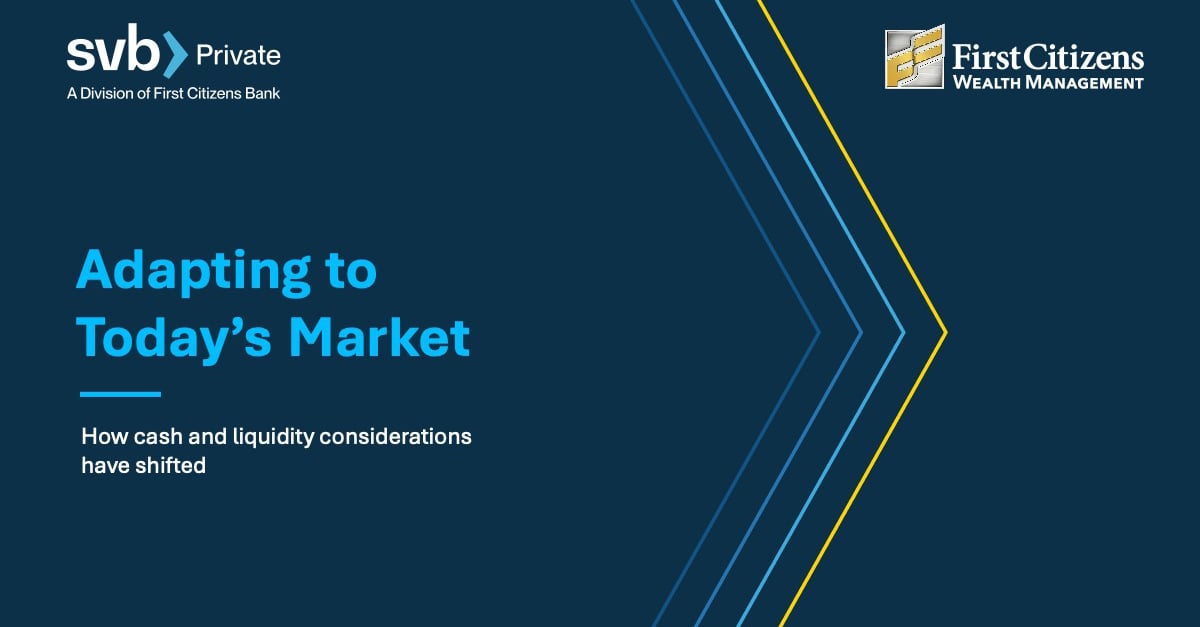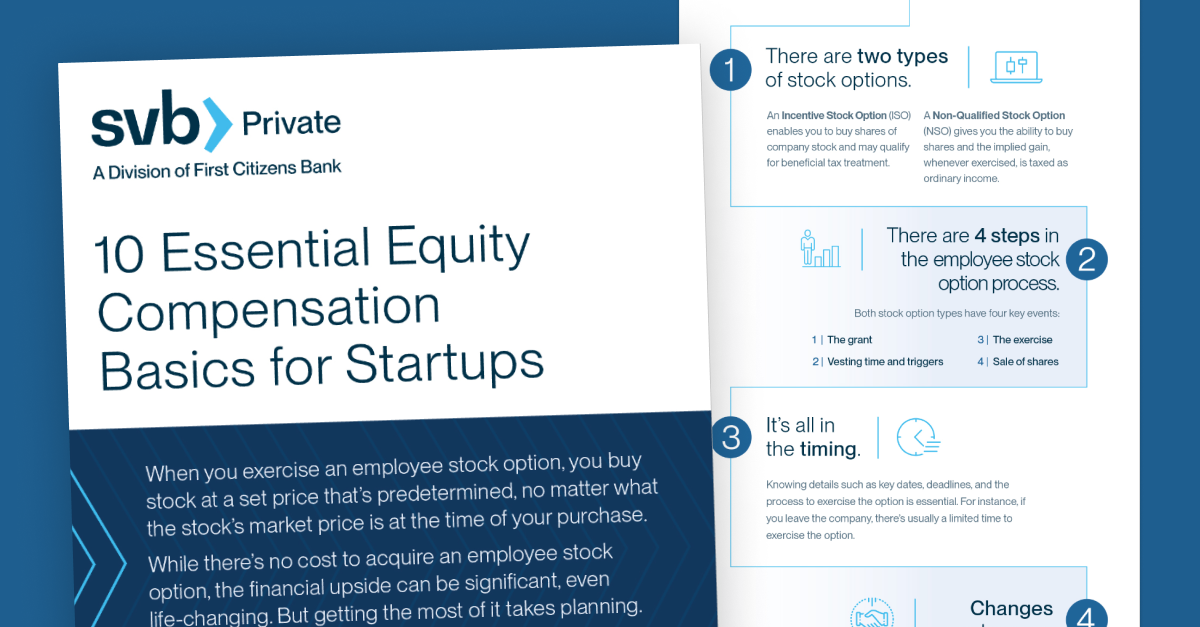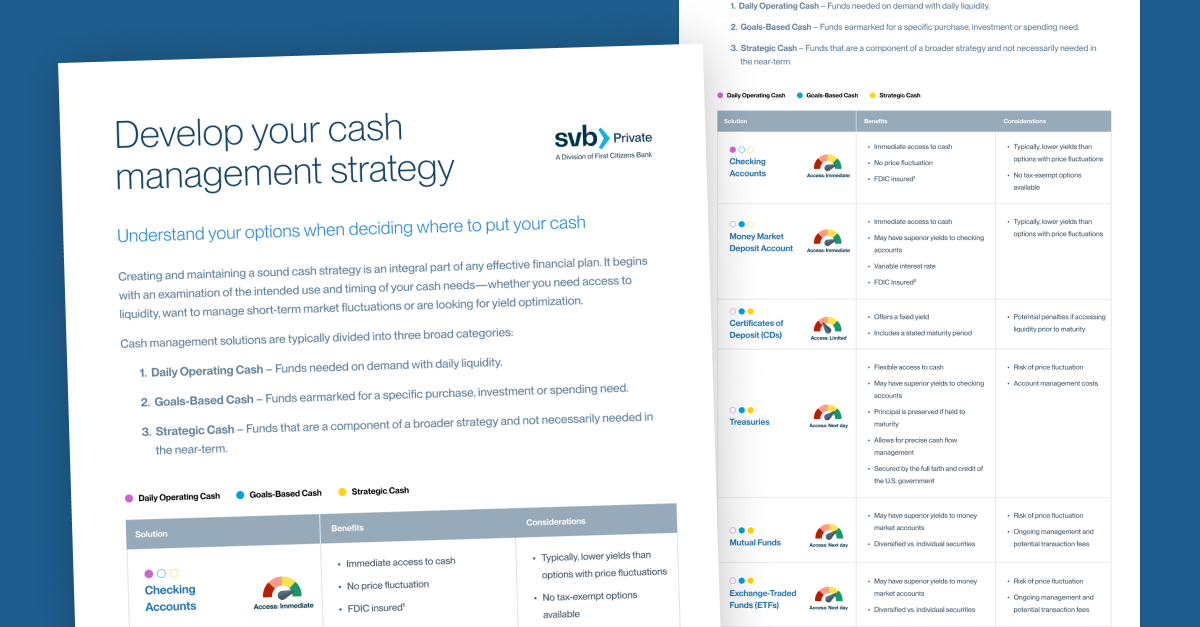We’re pleased to provide you with insights like these from Boston Private. Boston Private is now an SVB company. Together we’re well positioned to offer you the service, understanding, guidance and solutions to help you discover opportunities and build wealth – now and in the future.
Ever wonder how you could be using debt as a strategic tool? Our own Gerald Baker sits down with our Head of Private Lending Karen Roses to discuss how using debt and leverage can be an important tool in a tax-efficient wealth plan.
Transcript
Gerald: Hello, and welcome to "Boston Private Perspectives." I'm Gerald Baker, co-head for the Center of Wealth Planning Excellence at Boston Private, as well as the head of Trust & Fiduciary Services. Today, we're going to dig into a topic that is often overlooked as part of a robust financial and estate plan -- opportunities to leverage your portfolio for borrowing.
Thank you for joining us today as we discuss lending as part of financial planning. So I'm privileged to be joined by my colleague today, Karen Roses, who is our head of Private Lending at Boston Private, and is responsible for strategizing and developing custom credit solutions and products for high net worth and ultra-high net worth individuals and families. Karen brings over 20 years of experience structuring complex and creative private loans.
So Karen, to get us started, why do people borrow?
Karen: Well, Gerald, why do people borrow? It's a good question. Often, it's to gain something. So you're buying a house or real estate, cars, boats; perhaps it's to invest in an education for yourself or for a child; starting a company, or doing house renovations.
Other than gaining something, you can also use lending, or you can use credit to avoid using your cash savings. It allows you to bridge your income, so if you have a lumpy income or cash flow, you can use a line of credit to help pay for the items that you want or need in the moment and then pay back that balance once your income comes in. We see this often with a lot of our private equity clients who are required to make sometimes very large capital calls and, you know, they may not be receiving distributions until later on in their income cycle, so PE capital calls. And then, just for emergencies, just to have ability to dip into some type of liquidity or cash flow availability for anything that may happen over the course of the year.
So another reason that people borrow is to fund tax payments, whether it's quarterly tax payments, bridging income, or, you know, annual tax payments in April or October. And taxes have...a lot of people want to avoid them. And so there are ways that you can strategize using leverage to help offset or even avoid taxes.
One case, in particular, is for clients who have inherited or amassed stock that has a low-cost basis, rather than selling those shares as the stock appreciates or has appreciated, you can leverage those shares and use a line of credit to fund other investments or, you know, personal discretionary needs.
In one particular situation, we had a client who had sold his company and had, you know, spent years, decades watching stock appreciate. And he was in his 90s and the family was trying to determine how do we diversify, how do we ensure that we can continue to make capital calls and other investments without selling these shares? And so we put a pretty significant line of credit in place, and it would allow the family and the client to have that liquidity, knowing that, at his death, the cost basis of the shares would step up and he wouldn't be responsible for the capital gains, yet he would still be able to sell and pay back the outstanding balance on the line of credit. That's one particular example.
Other examples include using debt to fund investments that could...and the interest on those debt facilities could be characterized as investment interest expense. So working with your accountant, you can make a determination if that's something that could help with offsetting your taxes. And then, of course, the one that everyone knows a lot about is the mortgage interest deduction. And if you put a mortgage in place, you can deduct the interest up to principal amount of $750,000.
So those are some examples of why people use debt.
Gerald: You know, Karen, that's a really interesting thing because I also think that our clients, or at least the ones that I've experienced with you and the others, don't necessarily think of debt as part of an efficient tax strategy for tax mitigation, whether it be the deductibility of interest for those credit facilities or leveraging those credit facilities to mitigate realizing capital gains on very low basis stock. So it also becomes an integral component of looking at your broader estate and financial planning needs, doesn't it?
Karen: Oh, absolutely. Absolutely. And I think everyone has a certain comfort level with that. And when you're thinking about how you can be the most efficient with your portfolio, all of your assets, taxes, and planning into the future, leverage is a tool and it's something that should be considered as you have those conversations.
Gerald: Absolutely. So when you're thinking about leverage as a tool, and you're thinking about having, you know, helping a client frame their perspective on a credit facility or leveraging that as a tool, how do you work with clients to determine what is the right amount of debt to have?
Karen: Well, again, it all comes back to the individual. In most cases, it's determining how do you feel about debt? Do you have a source of repayment? What's the timeframe you're going to keep this debt in place? How low are the interest rates? How much are your payments going to be? Do you have the cash flow to support whatever those required monthly payments are? So that's the first piece of it.
From a bank perspective, the way that institutions, financial institutions typically look at debt service or a client's ability to repay debt is to calculate the monthly expenses that an individual has, and that would be loan payments, credit card payments, and then they compare it to monthly income. So whatever your cash flow is that comes in over the course of the month. So taking a mortgage, for example, the max amount that banks will allow is a 43% debt-to-income ratio. So back of the envelope, what you do is you take your income and you'd multiply it by 4.3, and that's the total amount of debt that you can support.
Now, this is to qualify for a loan, and, for many people, it would be a really uncomfortable amount, like it's a lot of debt. So it doesn't take into account any savings that you have, like if you're putting away money for 401(k), or if you have a child in private school or, you know, your spend rate might be a little higher one year over another. So I typically advise clients to look at more of a 35% debt to income, and that will give you a bit more cushion, so you can take the trip to Disney and not need to worry about it.
But there are other times when, you know, a client knows that there's going to be a windfall, there's going to be some type of transaction, whether it's selling a portion of a company that they own, or, you know, getting a distribution from a trust or an investment. And if that is a moment where they're bridging their illiquid time until that windfall comes in, then you can start to be more strategic about how you use and set up debt. Perhaps, you get a little bit more than you would normally get, as long as the bank allows for it. But you start to think about what are the sources of repayment, and that's how a banker would look at it too.
Gerald: I imagine, over the past few years, with record low interest rates and us anticipating record low interest rates for at least an interim period of time forward, that it's quite cost-effective for our clients who are looking to pursue credit facilities for these bridging and liquidity needs to leverage borrowing to do that. Is that...?
Karen: Absolutely, so 30-day floating LIBOR has been under 20 basis points, which makes it incredibly attractive. No doubt you've heard about mortgage rates being extremely low. I know, in the housing markets, there's a lot of all-cash offers and people are trying really hard to get into properties where there is a low supply, high demand community. So we see a lot of leveraging to bridge a transaction of that sort, so that they know that once they sell their property that they're moving out of, they're going to be able to pay it down. But yes, rates have been driving an awful lot of borrowing, both individually and commercially.
Gerald: That's great perspective. I appreciate that. So Karen, as we look at debt as a bridge for certain liquidity event needs, as a bridge for tax strategy, how does debt fit into an estate plan? When you're looking at trusts and investment vehicles, what are you typically seeing as opportunities to leverage debt as a solution in those scenarios?
Karen: Well, first, I would say, as you're writing your state plan and working with an attorney or a fiduciary specialist like yourself, Gerald, that the clients need to be aware of if they're going to need to borrow against those assets that they're moving out of their name and into the name of the trust. Revocable trusts or family trusts, you know, are typically the vehicles that are established during your lifetime. And I have watched many clients who, you know, think that they're not going to need debt, suddenly decide, "I want to buy my child a house. I want to help fund my grandchildren's education. And I don't want to sell the stock, the bonds, whatever the holdings are in that trust. So I'd like to borrow against them." And you need to have a trust that allows for the plegibility of those assets. So that would be the first thing.
The second thing is just to become aware that it's no longer the grantor or the person who's creating the trust's assets, so the trustee is the one who will be signing on all that documentation, whether it's an application or a loan agreement. And for some people, they think of it as their own funds, and it's just kind of setting this, legally, you do need to have the proper parties signing off on that loan.
The second one would be, in your revocable trust, this is typically when assets are moved out of your estate for the benefit of a spouse or children. They occur often at your death. They can be established beforehand, of course, but with your rev trust, we see a lot of beneficiaries asking if they can borrow against assets that have not yet been distributed to them. And so if you are setting up your revocable trust for the next generation, you want to think about is that something you want to allow them to do? It provides flexibility, but it can also...you know, if you have a person who's not financially comfortable, it could start to create some stressors on them, because they're borrowing against assets that aren't really theirs.
Gerald: Now, that's an interesting concept, just to interject there for a second, Karen, because you not only have to get the beneficiary to understand the value...the potential value of the loan, you also have to get the trustee engaged to agree that that is something that would be advisable for the benefit of the beneficiary, right? So you're dealing with multiple parties with different perspectives and vested interests.
Karen: Yeah, absolutely. And in many cases, you know, the trust is set up or for long term, and it may not be just one set of beneficiaries. It may be something that, you know, will go to the next generation. And so the trustee becomes very aware of, you know, just how to financially manage it. And in some cases, debt makes sense, especially if you're bridging that liquidity moment or liquidity transaction. In other cases, it doesn't make sense, and that becomes...it's at the trustee's discretion.
Gerald: That's great. Thank you.
Karen: Now, the other one I see, and this falls into the era of trust categories, the dynasty trust. And a lot of clients who are going through a liquidity transaction, like selling a company, they'll do a lot of planning upfront. And I know you've worked with many of these clients, Gerald, and I'm sure you've heard plenty of these stories. I think it's really important to point out that a lot of clients will tend to shift... Like they get all excited, you know, they want to make sure that they're doing the structuring in a way that's going to protect them, protect their families, you know, reduce taxes, but they'll shift all of their personal liquidity into these vehicles. And then once you do that, you reduce the ability to get benefit from those assets. And so if you set up a loan or you want to borrow against those assets, it can undo some of the benefits of the trust.
So these are the types of conversations that I often get involved in, in terms of making sure that we're not doing anything that's going to disrupt the estate plan, but also helps to provide the liquidity and whatever that solution is that the client needs. I remember very clearly, I had one client who had sold a medical device company, moved everything out of his estate, and then found this amazing property that he wanted to buy, and said, "You know, I'm going to access the funds of the trust." And reality was he couldn't do it. And sometimes you can over plan. Having conversations and, you know, keeping perspective of what you need, and taking care of yourself too, prior to, you know, giving it to your children or to the next generation.
The final ones that we see a lot of are LLCs and FLTs, so limited liability companies and family limited partnerships. Again, as wealth starts to grow, you start to get into more sophisticated vehicles. And the banks, if you're doing a loan against these types of entities, will want to trace back the source of funds, they'll want to know who the owner of the entity is. And sometimes, it becomes quite layered. So it's just collecting all of the operating agreements and documentation to ensure that the banks truly understand who the decision-maker is and who has the power to sign on it.
The other thing to think about too is a legal concept called consideration. You probably know this very well, Gerald. And I'll give an example. We had a client who was wanting the trust to borrow, and the collateral was held in three investment LLCs. And in this case, we needed to have the LLCs as pledgers, the trust as a borrower, but you still needed the trust, or I'm sorry, the LLCs as guarantors. And it's because...and help me with this one, Gerald. If you are borrowing and you don't have benefit in the collateral, then legally, it could be seen as, you know, the loan is not...
Gerald: It has a defective, it hasn't been perfected, yeah. You don't need help there, Karen, you took it home. Seeing how that’s correct.
Karen: So oftentimes, clients will be like, "I just don't understand why we need an extra layer, like why is there this guarantee?" And it's just a structuring component, but ultimately, you know, borrowing provides lots of flexibility. And when you work with the right people who know how to work with complex situations, you can gain liquidity and protect your financial and estate plan. And that's what we're here for.
Gerald: You know, it's interesting. I absolutely agree with everything you've said. It's interesting though, because our focus and our, sort of, value proposition of how we engage with our clients is to look at all of these things in an integrated fashion, right. And everything that you've just described, it really jumps out to me that lending estate and tax planning, as well as wealth management, more broadly, including investment management are all integral pieces of the puzzle to create the picture of what your potential lending options are. That really jumps out to me as yet another example of why a truly integrated delivery model to differentiate how you look at a client's broader situation is so vitally important, whether it be lending, tax mitigation, lending for bridging, tax mitigation, estate planning, you have to look at the bigger picture and then figure out how all of those pieces come together.
Karen: I couldn't agree more. And I think some of the best teams are the ones that are taking all aspects of the client's picture and working together. My favorite memories of client planning are where you have strategists, fiduciary experts, lenders, relationship managers, sitting at a table, bouncing off ideas in front of the client and the client can just sit back in the chair and watch, like, that brainpower happen and know that it's not just one person. It's not just the client trying to think through all of this, but it's a team of experts who are bringing their best thoughts and their best experiences together to come up with what the best solution is.
Gerald: That's fantastic, Karen, and that's a great summary of what we try to do every day in private lending, in private wealth management, in private banking, is come together to find solutions that meet our clients' needs both today and in the future.
Well, I really want to thank you for the time to go over this really, really vital topic that is a key component to providing optionality for our clients. And I want to encourage all of our clients to reach out to your Boston Private advisor to discuss your needs or elements of today's conversation. Providing guidance and support as your trusted adviser is core to our mission.
You can also read our latest perspectives on wealth planning by visiting bostonprivate.com. And whid you rare there, you can subscribe to our newsletters if you'd want all of this information delivered right to your inbox. You can follow @BostonPrivate on Facebook, LinkedIn, and Twitter for our timely thought leadership. And be sure to subscribe to the "Boston Private Perspectives" podcasts wherever you prefer to listen. Thank you for tuning in and thank you for joining me today, Karen.
Karen: Pleasure to be here, Gerald. Hope to do it again soon.














